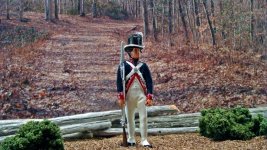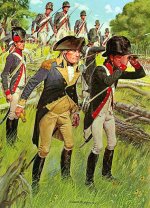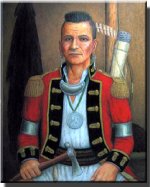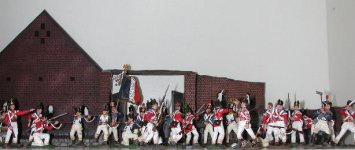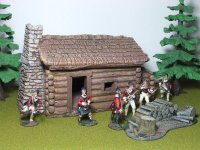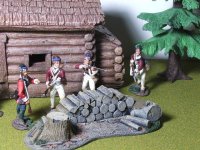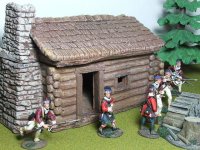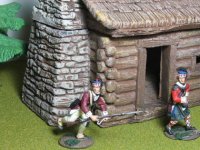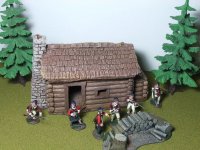You are using an out of date browser. It may not display this or other websites correctly.
You should upgrade or use an alternative browser.
You should upgrade or use an alternative browser.
Britains Displays & Dioramas (1 Viewer)
- Thread starter PolarBear
- Start date
PolarBear
Major
- Joined
- Feb 24, 2007
- Messages
- 6,706
AFTER THE TIMBERS FELL: OHIO 1794
Richard Jones, a Pvt. of the 1st Sublegion of the Infantry of the Legion of the United States is seen in the woods where two months before the Battle of Fallen Timbers was fought between the United States Army and the Western Confederacy of Indians led by Blue Jacket. The American victory gave the U.S. government control over the lands of the Northwest Frontier that had belonged to the Indians. The battle was called "Fallen Timbers" because the Ohio woods where it took place had been the scene of a tornado that toppled many trees in the woods. [FIGURE WB # 43068]
The Legion of the United States had been established in 1792 by Secretary of War Henry Knox. Its commander was Major General Anthony Wayne. The new army was influenced by the Legions of Ancient Rome since Knox and Wayne had been students of the writings of Julius Caesar. The Legion was divided into Sublegions with their own identifying color for plume and hat border. The 1st Sublegion used the color white. Red and green were worn by the other Sublegions. The Roman influence was concurrent with the Classical Revival that swept America in the arts and culture during this time which witnessed the development of America as the "New Republic".
Richard Jones, a Pvt. of the 1st Sublegion of the Infantry of the Legion of the United States is seen in the woods where two months before the Battle of Fallen Timbers was fought between the United States Army and the Western Confederacy of Indians led by Blue Jacket. The American victory gave the U.S. government control over the lands of the Northwest Frontier that had belonged to the Indians. The battle was called "Fallen Timbers" because the Ohio woods where it took place had been the scene of a tornado that toppled many trees in the woods. [FIGURE WB # 43068]
The Legion of the United States had been established in 1792 by Secretary of War Henry Knox. Its commander was Major General Anthony Wayne. The new army was influenced by the Legions of Ancient Rome since Knox and Wayne had been students of the writings of Julius Caesar. The Legion was divided into Sublegions with their own identifying color for plume and hat border. The 1st Sublegion used the color white. Red and green were worn by the other Sublegions. The Roman influence was concurrent with the Classical Revival that swept America in the arts and culture during this time which witnessed the development of America as the "New Republic".
Attachments
PolarBear
Major
- Joined
- Feb 24, 2007
- Messages
- 6,706
AFTER THE TIMBERS FELL: OHIO 1794 continued
Below is historical information about the Battle of Fallen Timbers from the website of Ohio History Central and 2 illustrations:
Illustration 1: The Battle of Fallen Timbers showing the First Sublegion in action (by H. Charles McBarron, Company of Military Historians)
Illustration 2. Portrait of Blue Jacket (by Hal Sherman 2007)
Battle of Fallen Timbers
Ohio History Website
http://www.ohiohistorycentral.org/entry.php?rec=473
In 1792, President George Washington appointed Anthony Wayne as the commander of the United States Army of the Northwest, then currently serving in the Northwest Territory. The major purpose of this army was to defend American settlers from Indian attack. Josiah Harmar and Arthur St. Clair had both suffered defeat at the hands of Native Americans in the previous few years, and Washington hoped that Wayne would be more successful. Wayne arrived with additional troops to supplement the Army of the Northwest in May 1793. He positioned his force at Fort Washington, near Cincinnati. Wayne had hoped to move against the natives immediately, but smallpox and influenza weakened his men severely. In October, Wayne finally left the Cincinnati area and headed to Fort Jefferson. He proceeded six miles to the north of Fort Jefferson and ordered the construction of Fort Greene Ville. His army remained here for the winter of 1793-1794. He also had his men build Fort Recovery on the site of St. Clair's Defeat.
Tensions escalated between the Americans and the Indians during the summer of 1794. On June 30, 1,500 Shawnee Indians, Miami Indians, Delaware Indians, Ottawa Indians, and Ojibwa Indians led by Little Turtle attacked a supply train leaving Fort Recovery for Fort Greene Ville. In late July, Wayne moved into the heart of Indian Territory. In early August, he ordered his men to construct Fort Defiance to protect his army as well as to serve as a supply depot. During this time, Wayne's men also destroyed native villages and crops. Believing that the Indians needed to sue for peace, Little Turtle, a leader of the Miami Indians refused to lead the tribes into battle and deferred to Blue Jacket, a Shawnee leader.
As Wayne moved toward the Maumee River, the Indians prepared to attack him in an area known as Fallen Timbers. It was a place where a tornado had knocked down many trees. The Indians expected the Americans to arrive on August 19, but the white soldiers did not arrive until the next day. The natives fasted before the battle for spiritual and cultural reasons and to avoid having food in their stomachs. The likelihood of infection increased if a person was wounded in the stomach and there was food in it. By August 20, the natives were weak from hunger.
Although the Indians used the fallen trees for cover, Wayne's men quickly drove the Indians from the battlefield. The Americans had thirty-three men killed and roughly one hundred wounded, while the Indians lost approximately twice that number. The fight became known as the Battle of Fallen Timbers. Blue Jacket's followers retreated to Fort Miamis, hoping the English would provide them with protection and assistance against Wayne's army. The English refused. Wayne followed the natives to the fort. Upon his arrival, Wayne ordered the British to evacuate the Northwest Territory. The English commander refused. Rather than force the issue, Wayne decided to withdraw to Fort Greene Ville.
For the next year, Wayne stayed at Fort Greene Ville, negotiating a treaty with the Indians. The natives realized that they were at a serious disadvantage with the Americans, especially because of England's refusal to support the Indians. On August 3, 1795, the Treaty of Greeneville was signed. Representatives from the Miami Indians, the Wyandot Indians, the Shawnee Indians, the Delaware Indians, and several other tribes agreed to move to the northwestern part of what is now the State of Ohio. Not all Indians concurred with the treaty, and bloodshed continued to dominate the region for the next twenty years as Americans and Indians struggled for control.
Below is historical information about the Battle of Fallen Timbers from the website of Ohio History Central and 2 illustrations:
Illustration 1: The Battle of Fallen Timbers showing the First Sublegion in action (by H. Charles McBarron, Company of Military Historians)
Illustration 2. Portrait of Blue Jacket (by Hal Sherman 2007)
Battle of Fallen Timbers
Ohio History Website
http://www.ohiohistorycentral.org/entry.php?rec=473
In 1792, President George Washington appointed Anthony Wayne as the commander of the United States Army of the Northwest, then currently serving in the Northwest Territory. The major purpose of this army was to defend American settlers from Indian attack. Josiah Harmar and Arthur St. Clair had both suffered defeat at the hands of Native Americans in the previous few years, and Washington hoped that Wayne would be more successful. Wayne arrived with additional troops to supplement the Army of the Northwest in May 1793. He positioned his force at Fort Washington, near Cincinnati. Wayne had hoped to move against the natives immediately, but smallpox and influenza weakened his men severely. In October, Wayne finally left the Cincinnati area and headed to Fort Jefferson. He proceeded six miles to the north of Fort Jefferson and ordered the construction of Fort Greene Ville. His army remained here for the winter of 1793-1794. He also had his men build Fort Recovery on the site of St. Clair's Defeat.
Tensions escalated between the Americans and the Indians during the summer of 1794. On June 30, 1,500 Shawnee Indians, Miami Indians, Delaware Indians, Ottawa Indians, and Ojibwa Indians led by Little Turtle attacked a supply train leaving Fort Recovery for Fort Greene Ville. In late July, Wayne moved into the heart of Indian Territory. In early August, he ordered his men to construct Fort Defiance to protect his army as well as to serve as a supply depot. During this time, Wayne's men also destroyed native villages and crops. Believing that the Indians needed to sue for peace, Little Turtle, a leader of the Miami Indians refused to lead the tribes into battle and deferred to Blue Jacket, a Shawnee leader.
As Wayne moved toward the Maumee River, the Indians prepared to attack him in an area known as Fallen Timbers. It was a place where a tornado had knocked down many trees. The Indians expected the Americans to arrive on August 19, but the white soldiers did not arrive until the next day. The natives fasted before the battle for spiritual and cultural reasons and to avoid having food in their stomachs. The likelihood of infection increased if a person was wounded in the stomach and there was food in it. By August 20, the natives were weak from hunger.
Although the Indians used the fallen trees for cover, Wayne's men quickly drove the Indians from the battlefield. The Americans had thirty-three men killed and roughly one hundred wounded, while the Indians lost approximately twice that number. The fight became known as the Battle of Fallen Timbers. Blue Jacket's followers retreated to Fort Miamis, hoping the English would provide them with protection and assistance against Wayne's army. The English refused. Wayne followed the natives to the fort. Upon his arrival, Wayne ordered the British to evacuate the Northwest Territory. The English commander refused. Rather than force the issue, Wayne decided to withdraw to Fort Greene Ville.
For the next year, Wayne stayed at Fort Greene Ville, negotiating a treaty with the Indians. The natives realized that they were at a serious disadvantage with the Americans, especially because of England's refusal to support the Indians. On August 3, 1795, the Treaty of Greeneville was signed. Representatives from the Miami Indians, the Wyandot Indians, the Shawnee Indians, the Delaware Indians, and several other tribes agreed to move to the northwestern part of what is now the State of Ohio. Not all Indians concurred with the treaty, and bloodshed continued to dominate the region for the next twenty years as Americans and Indians struggled for control.
Attachments
Dickbuttons
Sergeant
- Joined
- Aug 22, 2005
- Messages
- 728
Thanks for the photo and the history. Really good reading.
kogu
2nd Lieutenant
- Joined
- Mar 1, 2007
- Messages
- 3,635
Donnie,
I agree. The Britains/1st Gear matte figures are very well done and so are the traditional style glossy figures.
Attached I do have a few pictures of the AWI 71st Highlanders I recently purchased.
Your shelf dioramas look beautiful. Thanks for sharing the views.
Konrad
I agree. The Britains/1st Gear matte figures are very well done and so are the traditional style glossy figures.
Attached I do have a few pictures of the AWI 71st Highlanders I recently purchased.
Your shelf dioramas look beautiful. Thanks for sharing the views.
Konrad
Attachments
kilted vampire
Lieutenant Colonel
- Joined
- Mar 2, 2006
- Messages
- 7,900
You guys are starting to get the hang of this dio stuff. Keep it up. Those Shleich trees are a gas. It is encouraging to see people do something with their figures.
Ken & Ericka Osen/H&A Studio
Command Sergeant Major
- Joined
- Jun 22, 2005
- Messages
- 2,113
Hello There!
Thought you might enjoy seeing a couple of photographs that we staged on the new display base we built for W.Britain. We had been to the Gettysburg battlefield so many times we couldn't help seeing the unpopulated display looking just a natural to our eye as a visitor to the site 145 years after the tragic events that took place there.
The base is 24" x 24" square and designed with a typical 19th century stone fence and a small stand of trees. It was photographed in our studio with a sky backdrop I painted some years ago. Hope you enjoy.
Ken
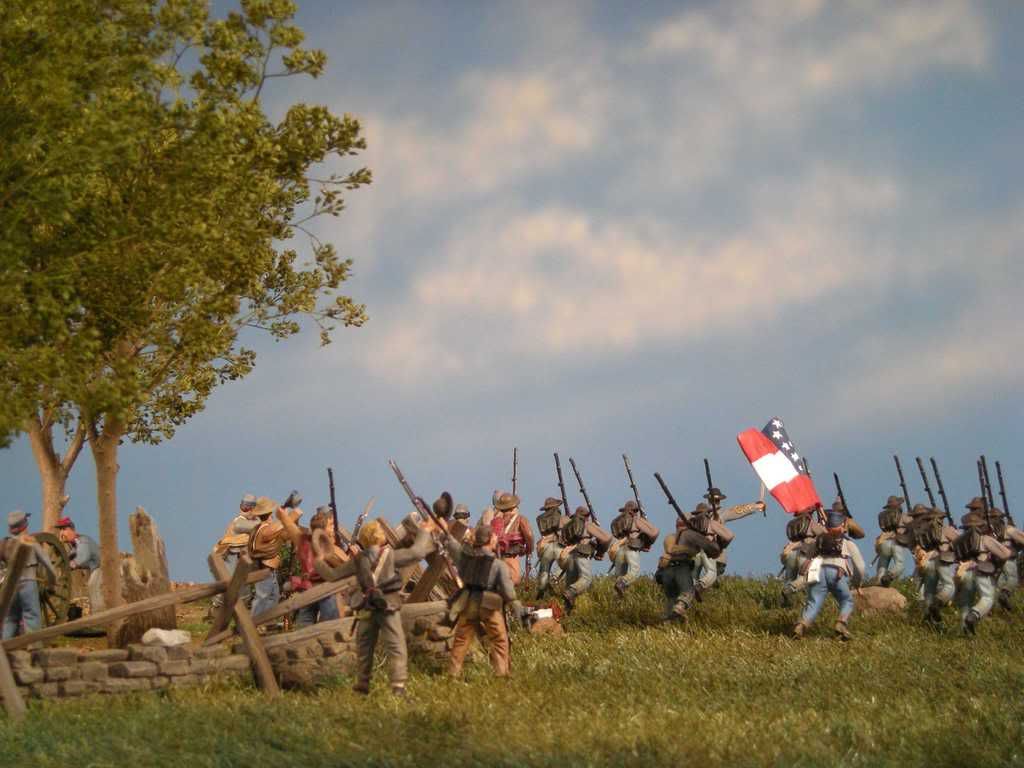
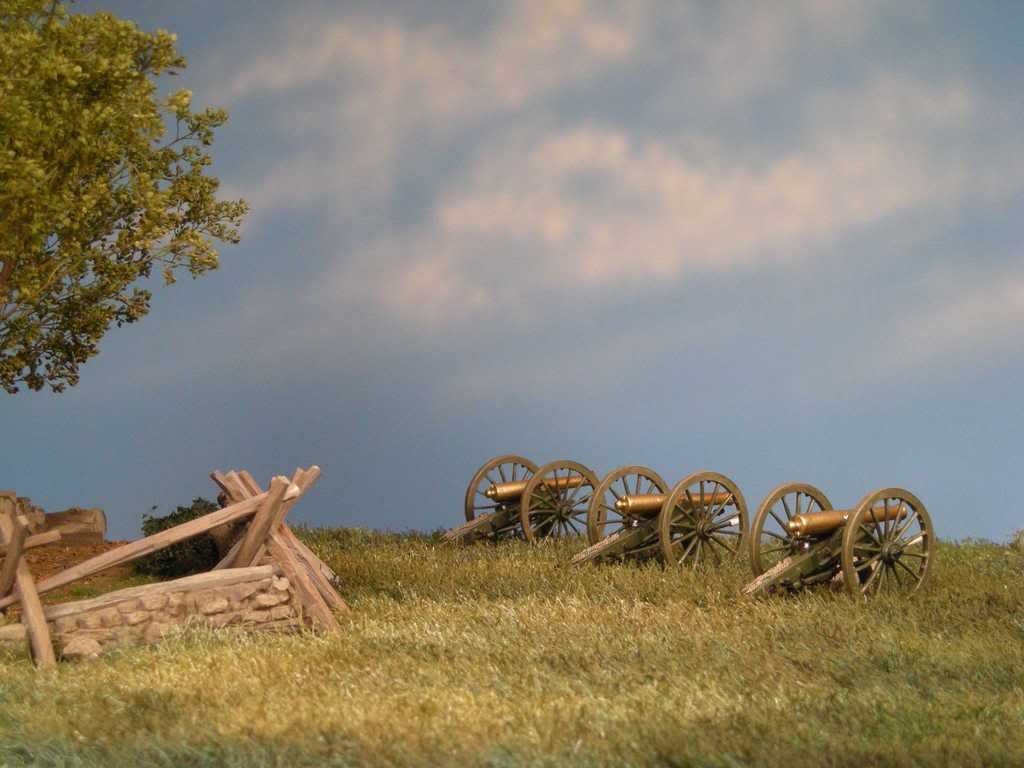
Thought you might enjoy seeing a couple of photographs that we staged on the new display base we built for W.Britain. We had been to the Gettysburg battlefield so many times we couldn't help seeing the unpopulated display looking just a natural to our eye as a visitor to the site 145 years after the tragic events that took place there.
The base is 24" x 24" square and designed with a typical 19th century stone fence and a small stand of trees. It was photographed in our studio with a sky backdrop I painted some years ago. Hope you enjoy.
Ken


Ken & Ericka Osen/H&A Studio
Command Sergeant Major
- Joined
- Jun 22, 2005
- Messages
- 2,113
Here is another view of the same diorama from the other side.
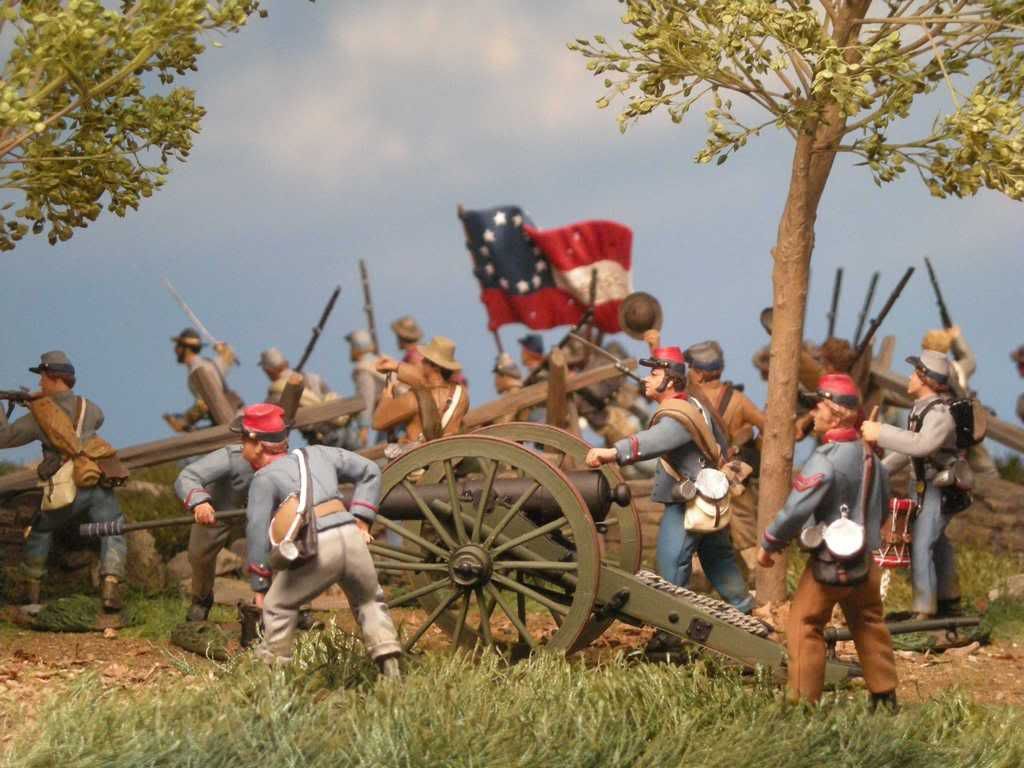

Ken & Ericka Osen/H&A Studio
Command Sergeant Major
- Joined
- Jun 22, 2005
- Messages
- 2,113
Thanks Randy
I have built hundreds of these trees over the years. It is amazing how a relatively small model railroad layout can consume these to the point where you consider modeling more tree stumps than you really wanted! Several days worth of work can usually be planted in less than an hour.
Ken
I have built hundreds of these trees over the years. It is amazing how a relatively small model railroad layout can consume these to the point where you consider modeling more tree stumps than you really wanted! Several days worth of work can usually be planted in less than an hour.
Ken
Mister Dave
Command Sergeant Major
- Joined
- Dec 19, 2007
- Messages
- 2,037
Those are really nice, Ken. Is that the same resilient grass material you've used in some of your other photos fairly recently? Also, do you sell trees like these at H&A?
Dave
Dave
Ken & Ericka Osen/H&A Studio
Command Sergeant Major
- Joined
- Jun 22, 2005
- Messages
- 2,113
Hi Dave!
Yes, this is the grass that I have mentioned before. We have been using it during the last couple of years on our displays, including the ones we recently made for the new Treefrog shop. What I like about it is the flexibility it gives you in moving your figures around and the look of pre 20th century landscapes. When viewed at a low angle it also disguises the bases.
The trees pictured, as well as Fall and Winter trees we have made, are used on the shop built displays that we have been providing for Museums and private collectors for years. We have been building a couple of new ones for my own display cases here including a Winter one. I will try to post a couple of images when they are done.
All the Best!
Ken
Yes, this is the grass that I have mentioned before. We have been using it during the last couple of years on our displays, including the ones we recently made for the new Treefrog shop. What I like about it is the flexibility it gives you in moving your figures around and the look of pre 20th century landscapes. When viewed at a low angle it also disguises the bases.
The trees pictured, as well as Fall and Winter trees we have made, are used on the shop built displays that we have been providing for Museums and private collectors for years. We have been building a couple of new ones for my own display cases here including a Winter one. I will try to post a couple of images when they are done.
All the Best!
Ken
Toy Soldier Brigade
Sergeant Major
- Joined
- Aug 5, 2005
- Messages
- 1,662
That grass looks great. Where can it be purchased ?
Users who are viewing this thread
Total: 2 (members: 0, guests: 2)


